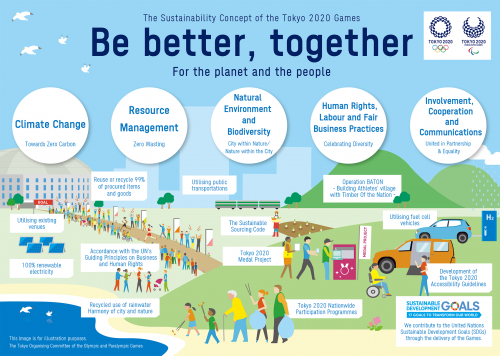Coreen Grant takes a reflective outlook on the opportunities the pandemic has presented us with in changing the impact sport has on the environment
'Looking forward, 2021 holds an unusually high number of major international sporting events.
by Coreen Grant
Sunday November 29 2020,
As England enters the second national lockdown of 2020, elite sport shows no signs of slowing down. International fixtures continue to be played, with teams like England Netball travelling as far as New Zealand to begin a three-match series. Looking forward, 2021 holds an unusually high number of major international sporting events. With some events postponed from 2020, the sporting calendar promises to be particularly packed. England Netball will be joined in New Zealand by rugby teams from across the globe for the Rugby World Cup (women’s), while the Rugby League World Cup (men’s, women’s and wheelchair) will take place closer to home, in venues across England. Other major events in the calendar include the Euro 2020 Championship, the Invictus Games, and, of course, the 2020 Tokyo Olympic and Paralympic Games. With global audiences having endured tight restrictions throughout the pandemic, a stimulating series of gripping international sport seems just the ticket.
Or does it? Since the beginning of lockdown measures, voices across the political spectrum have been drawing attention to the unique opportunity the pandemic presents to change the way that society operates, for the better. A ‘green recovery’ from COVID-19 is near the top of national priorities, but how does a schedule of mega sporting events sit within a greener future? From the new infrastructure required for an Olympic Games, to the footprint of flying entire squads and fan-bases across the globe, it is clear that large-scale sporting events are at odds with efforts to decarbonise the economy and tackle climate change. CO2 emissions are not the only problem, either; mega sporting events generate tonnes of garbage and food waste and consume colossal amounts of energy in powering stadiums and their water usage.
“A ‘green recovery’ from COVID-19 is near the top of national priorities, but how does a schedule of mega sporting events sit within a greener future?”
Although the environmental sustainability of sport is not widely discussed in the mainstream nor in academic literature, the question is not a new one. Recognition of the importance of the relationship between sport and the natural environment dates back at least to the 1994 Winter Olympics in Lillehammer, Norway. Concerns around the negative environmental impacts of the Games were addressed by carefully planned construction of facilities and initiation of more than twenty sustainability projects. As a result, the 1994 Olympics became widely regarded as the first ‘Green Games’. Since 1994, the sport industry has developed critical strategies to mitigate environmental impact via two main types of initiatives: reducing the ecological footprint of sport, and using sport as a means to raise environmental awareness. The former is not a simple goal, as this Forbes article shows. It is difficult enough to assess the global environmental impact of sporting events, let alone create strategies to address them. And the sporting industry, like many others where environmental measures can be at odds with profit, has not always wanted to address these issues. Host cities, attracted to mega sporting events by the lure of funding and boost in tourism, often encounter unforeseen – or at least unaccounted for – consequences. One problem is the tendency for host cities to relax rules around urban development and restructuring. This happened in the run-up to the 2014 World Cup and 2016 Olympic Games in Brazil; politicians in Rio executed ‘flash-votes’ to pass emergency bills, annulling the laws protecting historical architecture in order to develop the desired infrastructure. In such cases, physical goals such as state-of-the-art stadiums are prioritised to the neglect of their social and environmental impact. Likewise, the cost of mega sporting events is frequently borne out by public funding, even though local residents often cannot afford to attend such events, which are targeted towards the elite foreign traveller – another contributor to pollution. The legacy of the 1994 ‘Green Games’ seems to have gotten lost somewhere along the way. But is this still the case today, when the environment is increasingly at the forefront of development considerations?

Among the world’s largest sporting events, the Tokyo Olympic and Paralympic Games (Tokyo 2020) provides an ideal case study. The pandemic forced the Games to reschedule to summer 2021, but from their conception Tokyo 2020 has aimed to be the most sustainable Games yet. This focus is summed up by the motto, ‘Be better, together – For the planet and the people’. Tokyo’s Governor, Yuriko Koike, wrote that, “unlike many past Olympic hosts, the city is also committed to embedding long-term economic, social, and environmental needs into all planning processes”. To do so, Tokyo 2020 has shaped its approach around the UN’s 2030 Agenda for Sustainable Development, and the seventeen Sustainable Development Goals (SDGs). The UN specifies: “sport is also an important enabler of sustainable development”. Tokyo 2020 made an early and well-publicised statement in this regard by announcing that the iconic Olympic medals would be made from recycled metals, and the award ceremony podiums from household plastic waste – an emblematic signal of things to come. But how do the plans for Tokyo 2020 go beyond symbolic gestures?
Tokyo’s website has an entire section dedicated to their sustainability concept, goals and policies. It is clearly designed to be accessible to a wide range of readers. A page specifically aimed at people attending the Games lists possible actions to reduce their environmental impact, including: offsetting the carbon of their flights, using public transport, segregating waste at venues for recycling, reducing single-use plastic, saving energy during hotel stays, and reducing food waste. Although Tokyo’s wider sustainability approach includes themes such as biodiversity and co-operation, the reduction of emissions to tackle climate change is at the forefront of its campaign. The Carbon Offset Programme, ‘Towards Zero Carbon’, aims to encourage energy-saving measures and the use of renewable energy in both the preparation phase and during the actual games. But as any environmental activist will point out, carbon offsetting is little comfort in a time when the world needs to drastically reduce its overall emissions, not just offset extra. In this regard, the current trajectory for international sport hardly tallies with a green future. Yet, with its incredible cultural and social significance, it is difficult to imagine international sport is going anywhere soon.

This brings us back to the second strategy adopted by the sporting industry to mitigate environmental impact: using sport as a means to raise environmental awareness. This strategy is clearly a cornerstone in Tokyo 2020’s concept of a sustainable Games. They state that spreading efforts to reduce and absorb emissions worldwide, including encouraging citizens to adopt both individual and collective actions, is equally as important as reducing their own emissions. A vivid visual example is the concept design for the Athlete’s Village Plaza – ‘A Village Plaza Built by All’. Involving a ‘Japanese lumber relay’, the Plaza will be constructed from lumber borrowed from local governments across Japan, to symbolise communities uniting under the Games. After the Plaza is dismantled, the lumber will be returned to the original governments to be used as a legacy in public facilities and elsewhere. It is hoped that concepts such as these will help to realise an environmentally responsible Games, while also inspiring sustainable action throughout society.
Perhaps initiatives like these, which capitalise on the global reach of mega sporting events to promote more sustainable ways of living, are at least a partial answer to how international sport can reconcile its place within a greener future. But are the benefits of awareness initiatives enough to offset the industry’s own emissions? Even with rigorous efforts to make Tokyo the greenest Games ever, this remains to be seen. 2021 is set to be a crucial year when the sports industry will need to demonstrate that large-scale, international sport is environmentally viable in the long-term – or risk that it will be relegated as a fundamentally energy-wasteful industry.
Varsity is the independent newspaper for the University of Cambridge, established in its current form in 1947. In order to maintain our editorial independence, our print newspaper and news website receives no funding from the University of Cambridge or its constituent Colleges.














